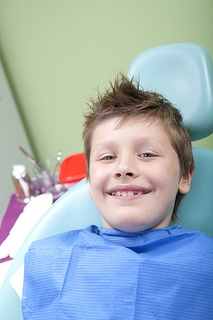March 21st, 2013

Many developing orthodontic problems can be intercepted and corrected if diagnosed and treated at an early age. Dr. Brent Nickolaychuk and our team at Kildonan Orthodontics recommend children have their first orthodontic evaluation no later than age 7, or younger if the front four permanent teeth have replaced the baby teeth. Early treatment, also known as interceptive treatment or Phase I treatment, provides both timely detection of problems and greater opportunity for more effective treatment. Early intervention guides growth and development, preventing serious problems later. When orthodontic intervention is not necessary, an orthodontist can carefully monitor growth and development and begin treatment when it is ideal.
If your child is showing these signs, it may be time to think about early orthodontic treatment:
• Early or late loss of baby teeth (your child should typically start losing teeth around age 5 or 6, and will have all their permanent teeth in around age 12-13)
• Difficulty chewing and/or biting
• Mouth breathing
• Sucking his or her thumb
• Speech impediment
• Protruding teeth (the top teeth and the bottom teeth extend away from each other)
• Crowded front teeth
• Teeth that don't come together in a normal manner or even at all
Early intervention will greatly reduce the severity of your child’s case, and therefore reduce the length of treatment time and cost for a second phase of treatment when all of his or her permanent teeth have erupted. An evaluation at our Winnipeg or Selkirk, MB office will determine if your child’s dental and skeletal growth is proceeding properly or if interceptive treatment is needed. Many times the developing problem can be corrected using sophisticated removable appliances instead of traditional orthodontic treatment.
To schedule a consultation for your child to visit with Dr. Brent Nickolaychuk, please give us a call! We will provide your child with an initial exam, and discuss with you the best steps to take toward caring for your child's smile.

March 14th, 2013
 Millions of people wear green on St. Patrick’s Day so they can show their spirit for the holiday and avoid getting pinched. While it may be easy for you to throw on a green shirt, sport a St. Patrick’s Day button, or wear a pair of emerald-hued shoes, if you’re an avid St. Patty’s Day enthusiast you may want to try something different this year. Our office thought of a few ideas that will help you take your holiday spirit to the next level:
Millions of people wear green on St. Patrick’s Day so they can show their spirit for the holiday and avoid getting pinched. While it may be easy for you to throw on a green shirt, sport a St. Patrick’s Day button, or wear a pair of emerald-hued shoes, if you’re an avid St. Patty’s Day enthusiast you may want to try something different this year. Our office thought of a few ideas that will help you take your holiday spirit to the next level:
Don Green Face Paint
Just like an avid sports fan on game day, you can use green face paints to showcase your enthusiasm for this holiday. Avoid breakouts or allergic reactions by only using paints that are specifically meant to be applied to the skin. A little bit of face paint can cover a large area, so feel free to get creative and decorate the whole family on St. Patrick’s Day.
Eat Green All Day
Not a fan of green eggs and ham? With the increasing popularity of green smoothies, there’s no better time to get in on this health craze. To create a green smoothie without the aid of food coloring, you can simply blend a generous amount of a leafy green vegetable, such as spinach or kale, with the ingredients that you would typically use to make a smoothie, like fruit, ice, milk, or juice. Keep the trend going throughout the day by using those same vegetables to create a green soup, egg salad, or a batch of bright green pastries. As an added bonus, you’ll get a healthy dose of vitamins without changing the taste of most of these foods.
If your old holiday routine has gotten stale, leave your green T-shirt in the drawer and try one or all of these tips. Don’t be surprised if you have so much fun that you decide to start a new, annual St. Patrick’s Day tradition! Have a happy St. Paddy’s day!
March 4th, 2013

This is a question we hear all the time. Malocclusion, or what we call having a “bad bite,” is the improper alignment of teeth and/or jaws. When your teeth and jaws are not properly aligned, it may impact your bite, the ability to properly care for your teeth, your gum tissue health and even your appearance. Most people will experience some degree of malocclusion, but it generally is not severe enough to require orthodontic treatment. If your malocclusion is serious enough, however, treatment may be necessary to correct the issue.
Untreated malocclusion can lead undesirable mouth problems, including tooth decay, gum disease, or chipped and cracked teeth. The most common solution for malocclusion, of course, is orthodontic treatment. The actual course of treatment, including the length of time you will require braces, will be determined by severity of your malocclusion. The goal of your treatment is to move your teeth into the proper position and correct any misalignment in the jaw.
We use the most advanced technology in the field in order to ensure that you receive the best possible results. If you have any questions about malocclusion or about starting your orthodontic treatment, please give us a call!
February 25th, 2013

Thank you for the question. In an age—and society—where looks matter as much as anything, and at a time when evenly-aligned teeth might be the difference between getting a job or a promotion, adults are choosing—wisely, we think—to invest in orthodontics. Orthodontic treatment can be successful at any age, and we know that adults especially appreciate the benefits of a beautiful and healthy smile.
If you are still apprehensive about getting braces as an adult, there is another straightening teeth option called Invisalign, which uses a series of invisible, removable and comfortable aligners that no one can tell you’re wearing. If you’ve been thinking about getting that perfect smile, we would love to have you visit for an initial consultation! Please give us a call to set one up!




